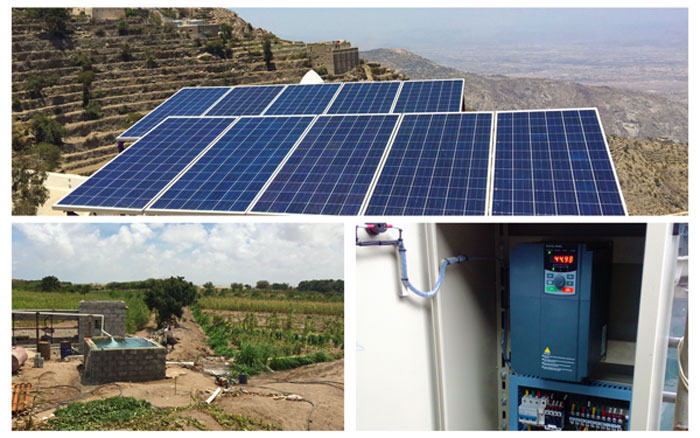Solar pump inverter plays a vital role in solar pump systems. When choosing a solar pump inverter, multiple factors need to be considered to ensure its performance, stability, and economy. In the selection of solar pump inverter, we need to know more about the basic professional knowledge of solar pump inverter to facilitate the purchase.
What is the solar pump inverter?
It is an off-grid or stand-alone inverter that converts DC power from solar panels (photovoltaic array) to AC power to supply a pumping system.
With solar radiation changes, solar panels' output DC power will change, so the solar inverter plays an important role in receiving such variable power and producing maximum AC power to the pump, also it adjusts output frequency in real-time so can run the pumping system at max efficiency.
Before deciding on the size of the solar pump inverter for the pump and solar panels, you need to confirm one thing first. What needs to be checked is the pump motor itself, and whether it is compatible and suitable for use with the inverter.
How to choose the rated power of the solar pump inverter?
When choosing the rated power of a solar pump inverter, you need to consider the following factors:
- Power demand of the water pump: First, you need to understand the rated power of the water pump used. Generally, the rated power of the solar pump inverter should be slightly greater than or equal to the rated power of the water pump to ensure that the water pump can be driven normally. For example, if the rated power of the water pump is 1.5kW, select an inverter with a rated power of 1.5kW or higher.
The inverter power capacity can be indicated according to the AC pump-rated current or power capacity. The general rule is 1.4 greater than the AC pump-rated current. Therefore, for a pump with a rated current of 5A, the inverter output current should be 5A * 1.4A = 7A. In addition, you can indicate the total power capacity of the solar panel according to the inverter power capacity. It is equal to the inverter power x 1.4 (same rule). - System voltage: Make sure that the input voltage of the solar pump inverter matches the voltage requirements of the solar panel and the water pump. Common system voltages are 12V, 24V, 48V, etc. When selecting, you must ensure that the voltages of various system parts are consistent. Solar pump inverter DC input voltage range. You need to know the following 2 things to indicate it: The maximum rated voltage of the solar module (panel), which can be easily obtained from the solar panel data sheet or nameplate. By understanding A and B, you can get the maximum voltage that can be received from the solar array, and then choose the inverter input voltage range so that this key value can be covered.
- Head and flow: According to the actual application needs, determine the head and flow requirements of the solar water pump. High-head and large-flow water pumps usually require higher-power inverters, and these factors need to be considered comprehensively when selecting.
- Solar resource conditions: According to the local solar resource conditions, reasonably configure the capacity and number of solar panels to ensure sufficient power can be provided within the rated power range of the inverter.
- Environmental conditions: Considering the temperature, humidity, and other harsh conditions of the installation environment, select an inverter with a protection level (such as IP65) to ensure that the equipment can operate stably even in harsh environments.
- System scalability: If there is a need for future system expansion, you can choose an inverter with a slightly higher rated power so that you don’t need to replace the inverter when the load is increased.
- Brand and quality: Choose a well-known brand and high-quality inverter to ensure its stable performance, long life, and guaranteed after-sales service.
Solar pumping inverter amazing features
- It runs and stops automatically according to sun radiation intensity (DC power), so can solve the instability issue of solar energy.
- It tracks the max power point of the solar panel, so can provide the max AC power to the pump (99% efficiency).
- Its input can be a regular power grid and solar power, so we can switch between them or even run the inverter at night with a regular power grid.
- Has a number of internal protections (over current, short circuit, lightening, overvoltage, undervoltage, ..., etc.) to protect the system.

even if I used Voc of string less than Voc of inverter
why solar pump inverter has max Dc power input